1. The Episcopal Mission in Texas
Episcopalians have had a presence in Texas since it was under the rule of Mexico, although they were not legally permitted to openly practice their faith at that time. During the Texas revolution in 1835, the Rev’d Richard Salmon led a missionary settlement from New York state, and established schools at Brazoria and Houston. Along with a fellow Anglican missionary priest named Chester Newell, Salmon applied to the Domestic and Foreign Missionary Society of the Episcopal Church for appointments as foreign missionaries, but they were denied. It was not until 1839 that the first Episcopal church was organized in Texas; the Rev’d Caleb Smith Ives established Christ Church at Matagorda. That same year, services were held in Houston, Galveston, Valesco, and Quintana. And Christ Church, Houston was also organized as a parish. (1)
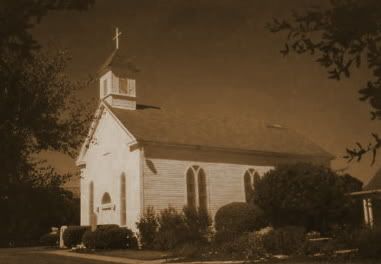
Above, Christ Church in Metagorda. Below, Bishop Leonidas Polk.
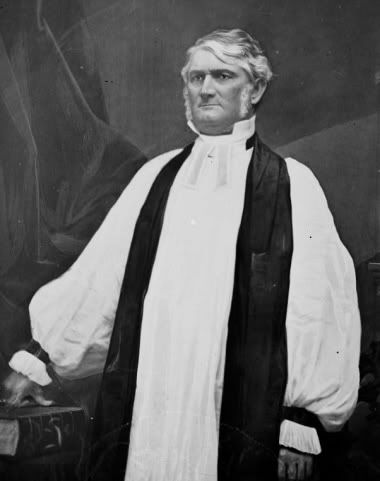
Bishop Leonidas Polk had oversight of these churches as Missionary Bishop of the Southwest. After visiting Texas in 1839, he recommended establishing a bishopric in Texas as soon as possible, especially since Bishop Polk himself had relatives who had migrated there from Tennessee and North Carolina. His venture across the Red River into northern Texas was called by Bishop Kinsolving the “first foreign missionary visit” of an Episcopal bishop, because Texas was at that time an independent Republic, and would remain so until 1845. (2)
At the General Convention of 1844, George Washington Freeman was elected as Missionary Bishop of the Southwest, with provisional oversight of the Church in the Republic of Texas. Texas was annexed to the United States in 1846, and the organization of the Diocese of Texas soon followed in Matagorda in 1849. In 1859, Alexander Gregg was elected the first Bishop of Texas. Growth was so extensive in the church there that the diocese petitioned General Convention for division in 1871. Three years later, Northern and Western Texas became two missionary districts—separated from the Episcopal Diocese of Texas in the Southeast. (3)
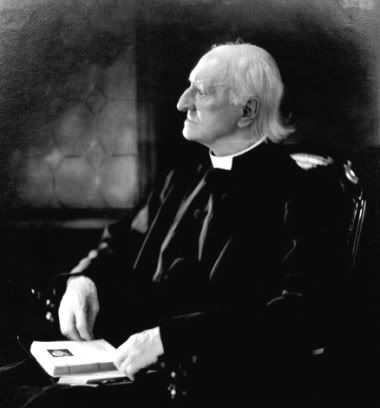
Above, The Right Rev'd Alexander Charles Garrett.
Alexander Charles Garrett, Dean of Trinity Cathedral in Omaha, was elected as the first bishop of missionary district of Northern Texas. A High Churchman of eloquence, learning, and passion, Garrett quickly set about building and planting churches in his mission field. He designated St. Matthew’s in Dallas as his cathedral and missionary outpost, and by 1895, the district had grown strong enough to become a diocese. The newly formed Diocese of Dallas remained such until 1910, when the Western portion was separated from Dallas as the remaining missionary district of Northern Texas. Garrett, the “Apostle to Northern Texas,” succeeded Daniel Tuttle as Presiding Bishop in 1923. His strong leadership, catholic faith, and missionary zeal left a lasting impression on the Episcopal Church around Dallas. (4)
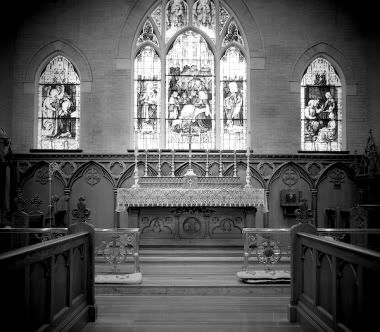
Above, the high altar of St. Matthew's Cathedral in Dallas.
The Dean of St. Matthew’s Cathedral in Dallas, Harry Tunis Moore, was elected coadjutor in 1917, and succeeded Garrett as diocesan in 1924. For Bishop Moore, the diocese existed to create and build strong parishes. (5) His successor, Charles Avery Mason, also worked tirelessly to move missions to parish status and to support parish expansion and construction projects. As Executive Secretary of the Forward in Service Movement, and then as Bishop of Dallas from 1946—1970, Mason’s zeal at his work was exercised at the risk of his own health.
Archibald Donald Davies, the fourth Bishop of Dallas, was, like Garrett, Dean of Trinity Cathedral in Omaha. And also like the first Bishop of Dallas, Davies had a heart for mission. But Davies coupled that concern with a stress on renewal and a strategy for the future. It is this bishop who brings forth the churches in Fort Worth to carry on this heritage with an innovative and evangelistic spirit in a rapidly changing ecclesiastical climate. The story of the young Episcopal Diocese of Fort Worth is one of being a missionary church in an era of conflict.
2. Catholic and Apostolic: Carving out a new Diocese
By 1982, the Diocese of Dallas had grown to encompass 115 parishes and missions, 244 resident clergy, and 39,000 communicants. These numbers were slightly down from the beginning of Bishop Davies’ ministry in Dallas in 1970. (6) However, it was thought that division of the diocese was an inevitable move whose time had come because of numerical growth and geographical concerns. A decade’s worth of long-range planning for mission, first investigated by Bishop C. Avery Mason, saw that the numerical growth in the two metropolitan centers necessitated some kind of change for the future of ministry in North Central Texas. Even with one suffragan, episcopal visitations could not be made yearly to every congregation as the situation stood in 1982.
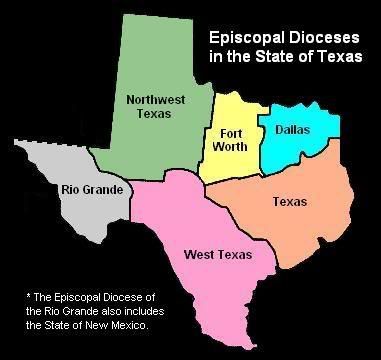
The territory of the new diocese of Fort Worth is highlighted in gold.
The Diocese of Texas, in comparison, decided to remain a large unit by having a second suffragan and help from assistant bishops. It is now the second largest diocese in the Episcopal Church. The case of Dallas was different geographically. The polarization of the twin cities of Dallas and Fort Worth provided mirror images of a diocese with rural missions supported by a large metropolitan see. It provided a nice even division, and the resulting jurisdictions were also more akin to the catholic model of a diocese, which is smaller in geographical size and oriented around a see city.
The division of 1 January 1983 was probably inevitable from the beginning, and it was the leadership of Bishop Davies that took advantage of this call to adventure in mission. As Bishop Garrett noted in the 1910 diocesan journal,
"The twin cities of Dallas and Fort Worth are growing like young giants. The little towns are stretching out their steel fingers with emerald rings strung all along to bind each other together in bonds of common life and hope of enterprise. They call upon me every day for enlarged facilities for doing their work." (7)
As separate jurisdictions, the two churches would be closer to the people, and be better able to equip them for mission in local congregations and beyond.
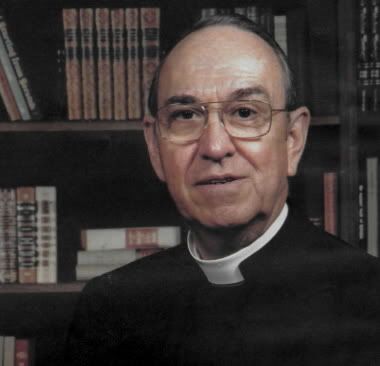
The Rev'd Canon James P. DeWolfe, Jr., of All Saints', Fort Worth.
The transition was smoothly achieved within six months of the decision by the diocesan convention—due in part to extensive planning and Bishop Davies’ leadership. Canon James DeWolfe, rector of All Saints’ Church in Forth Worth, noted, “The time was simply right. The homework was done, the need was clear, and General Convention was just around the corner.” (8) As part of his commitment toward a sound transition, Bishop Davies decided to accept the call to become the first bishop of the new (and the financially and numerically weaker) Diocese of Forth Worth.

The Rt Rev'd A. Donald Davies, first Bishop of Fort Worth.
Close working relations with the congregations and lay involvement were two of the founding principles of the Diocese of Fort Worth. In drawing up the constitution of the new diocese, emphasis was put on the participation of the deaneries—represented by the dean and one elected layperson on the Executive Council. This difference in the Fort Worth diocesan constitution was created to foster Bishop Davies’ goals of ensuring greater lay participation in decision making and prompting creative and cooperative adventures in ministry. (9)
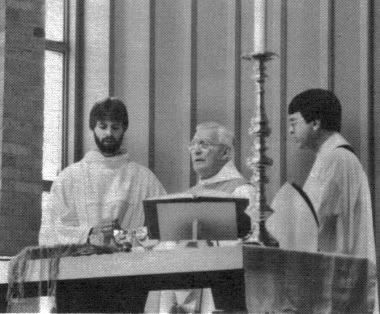
The Chrism Mass of the new diocese, held at St Christopher's.
Controversy was also a part of the birth of a separate Diocese of Fort Worth. Though, this aspect has probably been over-stressed in the past. By separating from Dallas, it is argued, the new diocese (like the Evangelical and Catholic Mission) could establish an orthodox safe-haven that would be for conservatives a “place to stand” within the Episcopal Church.
However, the deep division among the clergy, and to a lesser extent the laity, reflected at Bishop Iker’s election in 1992 indicated that this concept was more a perception than a reality. Likewise, Dallas was not necessarily carved out as a contrasting place of liberal experimentation as is sometimes thought. According to a survey by the search committee to elect a new bishop for Dallas in 1983, most of the laity in the diocese wanted their new bishop to take negative stands on the ordination of women, charismatic renewal, and homosexual ministries. (10)
In reality, for the Episcopal Church in Fort Worth, ministry and fidelity to the Church’s tradition have always gone together. The Church does not retain its teaching for itself, but for others. Therefore, as Bishop Garrett noted, the missionary idea “is the fundamental idea of an Apostolic Church.” (11) This thought resonated at the first diocesan convention of Fort Worth in October of 1983, when progress in missionary efforts was already being made.
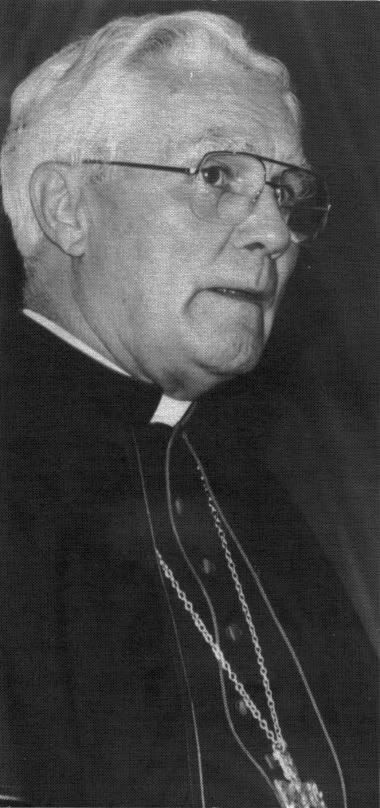
Bishop Davies of Fort Worth concluded his opening address by saying, “We are about to make a transition in Episcopal leadership in one of the most alive and exciting dioceses in the Anglican Communion.” As a part of this renewed missionary endeavor, Davies stated, “The Diocese of Fort Worth is here to stay as a witness to our Lord Jesus Christ and as a visible part of the One Holy Catholic and Apostolic Church.” (12)
3. Pope and the Partisanship
One of the reasons that the Diocese of Dallas was divided in 1982 was that Bishop Davies had announced that he would retire in 1985, and Davies did not want to leave the difficult task to his successor. Therefore, at the first diocesan convention in Fort Worth, Davies (now Bishop of Fort Worth) called for a coadjutor to be elected in 1984 to lead the new newly created diocese upon his retirement. Their choice was The Rev’d Clarence C. Pope, Jr., rector of St. Luke’s Episcopal Church in Baton Rouge, Louisiana. Bishop Davies did not end up retiring from active church ministry, however. At the request of Presiding Bishop John Allin, Davies went on to serve as bishop for the Convocation of American Churches in Europe from 1985-1988. (13)
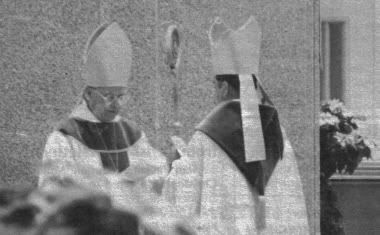
Bishop Davies hands the crozier to Bishop Pope after his consecration.
As the second Bishop of Fort Worth, Clarence Pope inherited Davies’ initiatives on renewal and mission. But what was to prove even more significant was that Pope inherited a position of leadership among the bishops of the Evangelical and Catholic Mission (ECM). Davies was also a member of the group, founded in 1976 by bishops Stanley Atkins and Charles Gaskell as a fellowship of conservative Episcopalians (particularly Anglo-Catholics) who decided to remain as an orthodox witness in the Episcopal Church following the first ordinations of women to the priesthood in Philadelphia in 1974. Other concerned churchmen, meeting in St. Louis in 1976, had decided to break with the national Church and establish churches that would continuing to maintain exclusive use of the 1928 Prayer Book and a male priesthood.
Bishop Clarence Pope took his role of leadership at home and on the national scene seriously. The chief areas of conflict for ECM within the national church were the ordination of women to the priesthood (authorized by General Convention in 1976) and the struggle to maintain biblical morality in teaching and practice. The struggle intensified with the election of Edmond Browning as Presiding Bishop in 1986, who, unlike previous the Presiding Bishop John Allin, enthusiastically supported the ordination of women as well as gay rights issues. With his strong will, eloquent voice, and depth of experience, Pope met these challenges head-on.
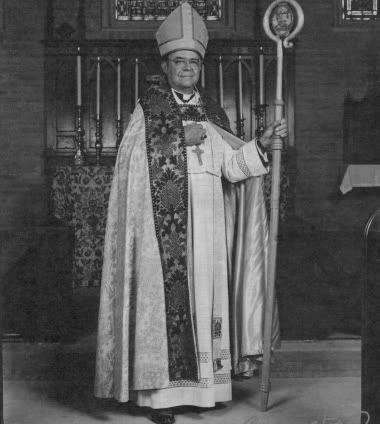
The Rt Rev'd Clarence C. Pope, Jr., II Bishop of Fort Worth.
The ordination of women quickly became the norm in most dioceses of the Episcopal Church. However, it was the election of the first female bishop (Barbara Harris as suffragan of Massachusetts) in 1988 that prompted action by the ECM. It was decided to convene a synod of the ECM clergy and people in Fort Worth on June 1-3, 1989. “The final crisis of the Episcopal Church is now upon us,” wrote the ECM bishops in a pastoral letter. They explained: "The purpose of this Synod will be to consider how we shall be the Church within the Episcopal Church and to adopt a detailed and unified plan for active witness in the face of the institution’s present disintegration." (14)
The meeting of the ECM in 1989 in Fort Worth begot a new organization to succeed it—the Episcopal Synod of America—with Bishop Pope as its first president. The election of a female diocesan seemed inevitable with the consecration of Bishop Harris, and did occur in 1993 when the Diocese of Vermont elected Archdeacon Mary Adelia McLeod of West Virginia as their diocesan bishop. The Synod dealt with the question of episcopal ministry for parishes that may not accept female bishops. In light of the episcopal visitor’s clause created by the 1988 General Convention, the ESA resolved to provide the ministry of alternative episcopal visitors where requested. (15)

Women Anglican bishops gathered at the 1998 Lambeth Conference.
This was, however, a provisional action. The advent of female diocesan bishops was approaching, and the movement toward the ordination of women was gaining momentum in England. While Pope was publicly trying to plug the leaks in the Episcopal Church, privately he was seeking a long-term solution. For Pope, the most promising solution lay beyond the Alps. “I was thrilled to the possibility for our communion [with Rome],” said Bishop Pope, “as the Anglican— Roman Catholic International Commission took up their work and made such wonderful progress in finding a way forward toward organic reunion between Rome and Canterbury.” (16)
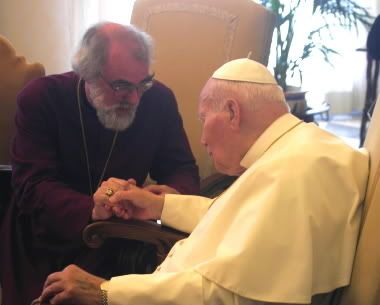
The official dialogue between the Pope and the Archbishop of Canterbury.
With the Roman and Anglican Communions going in opposite directions on the question of women’s ordination, that hope was steadily diminishing. But perhaps it still would be possible on a smaller scale. Was there a place for whole Anglican dioceses and associated parishes to find a home in the Roman Catholic Church? Bernard Cardinal Law of Boston, head of the Anglican Use congregations under the “Pastoral Provision” of 1980, was lobbying for an extension of the program in the United States.
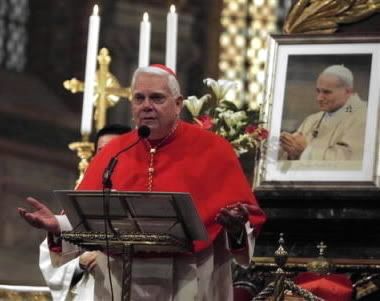
Bernard Cardinal Law, former Archbishop of Boston.
With the help of Cardinal Law, Bishop Pope attempted to negotiate at most a kind of personal prelature (modeled on Opus Dei) or perhaps an expanded pastoral provision similar to a uniat province (with their own liturgy and bishops, under Canon 372, §2) with the Holy See. Cardinal Hume of Westminster was also lobbying for a similar arrangement in England. Josef Cardinal Ratzinger, Prefect for the Congregation of the Doctrine of the Faith in Rome, was very supportive. In 1990, Bishop Clarence Pope met with Pope John Paul II, who embraced the Anglican bishop and gestured toward him, saying “in communion.” (17)
Prospects could not have appeared better, yet when Bishop Pope returned to Texas, nothing happened. Action on the plan had been stalled by Roman Catholic bishops in England. They did not want to receive a large faction of English Catholics opposed to the ordination of women and loyal to the pope. They produced a counter-proposal stating that Anglicans could convert as groups, but would then be absorbed into mainstream parish life. They could not maintain an Anglican identity as several parishes in the US had done under the pastoral provision.
This development essentially took away the Roman option for English Anglo-Catholics. With the succession of George Carey in the see of Canterbury 1991 and the approval of female priests in England in 1992, there were some conversions to Rome, but on a smaller scale and only as individuals. Back in America, what was once a communion-wide possibility and eventually only a diocesan possibility, was now merely a personal possibility. Many traditional Anglicans felt that the dawn of female priests in England left them no choice. In 1991, the parish of St. Mary the Virgin in Arlington voted to leave the Episcopal Diocese of Fort Worth for communion with Rome. On the other side of Fort Worth, the Church of the Holy Apostles decided that they could no longer remain in the Episcopal Church either. They changed their affiliation to the Antiochian Orthodox Church in 1992.

Bishop Pope, in ailing health and despondent over the long wait for a corporate reunion with Rome which was never to come, announced on 25 October 1994 that he would convert to Roman Catholicism upon his retirement at the end of the year. Bishop Pope cited the 1992 act of synod to ordain women as priests in the Church of England as the final impetus in his decision. “It was then,” said Pope, “that I became very aware that the pilgrimage I had longed to take corporately would now have to be taken alone.” While most of the leaders in the diocese sympathized with the bishop, others left behind in the Episcopal Church felt abandoned. His fellow ESA bishop, William Sheridan, remarked, “It’s a terrible self-centeredness.” (18)
Clarence Pope and his wife Martha were received into the Roman Catholic Church by Cardinal Law in a special ceremony at the former Episcopal parish of St. Mary the Virgin in Arlington. However, Pope’s plight was not over. The Popes retired to their former home of Baton Rouge in Louisiana. Clarence Pope presented himself to the local bishop for priestly ordination under the terms of the pastoral provision. Pope felt that a continuation of his ministry would allow him to serve out his calling in a new home. The Catholic bishop of Baton Rouge announced that he would be happy to ordain Pope as a priest . . . pending the approval of his diocesan priests’ council (which finally returned a negative vote).

Pope was isolated from the Catholic community in Baton Rouge and he started getting calls from his successor in Fort Worth, Bishop Jack Iker, and from Episcopal Presiding Bishop Edmond Browning to withdraw his resignation from the House of Bishops and return to the Anglican fold. Less than a year after their conversion, the Popes returned to the Episcopal Church. Pope confessed that he tended to idealize the Roman Catholic Church and found the reality somewhat different. He also noted increasing discomfort with the idea of absolute (re)ordination and a sense of guilt that he had abandoned traditionalists in the Episcopal Church. (19)
4. A Difficult Transition
Bishop Pope’s leadership—which tended to be perceived as equating national leadership in the ESA with leadership back in the Diocese of Fort Worth—was not without opposition at home. Some contested Pope’s conservative views; others agreed with them, but did not want to be drawn into a political struggle. All Saints’ Cathedral in Fort Worth (a generally conservative parish) was seen as being used to promote Pope’s agenda with which most parishioners agreed. However, the dean, the Very Rev’d William D. Nix, Jr. and members of the Vestry complained about being tied to the ESA’s national political struggle. A period of conflict between All Saints’ and the diocesan office led to the parish choosing to end its status as the pro-cathedral of the new diocese.
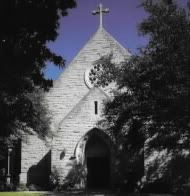
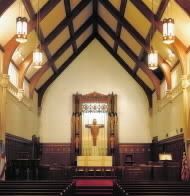
All Saints' Cathedral in Fort Worth.
Others were hoping to move the Diocese of Fort Worth more in line with the policies of the national church. In order to obtain episcopal assistance and forestall the possible election of a liberal successor, Pope called for the election of a coadjutor in 1992 without announcing his retirement. The ordination of women was a contentious issue throughout the election process. The nomination committee put forth four candidates—Fr. Jack Iker of the Church of the Redeemer in Sarasota, Florida; Fr. Keith Ackerman of St. Mark’s in Arlington, Texas; Dean Richard Hatfield of Christ Cathedral in Salina, Kansas; and Fr. Dwight Duncan of St. Matthias in Dallas. All four candidates indicated that they would neither ordain women as priests, nor license them to minister in the diocese.
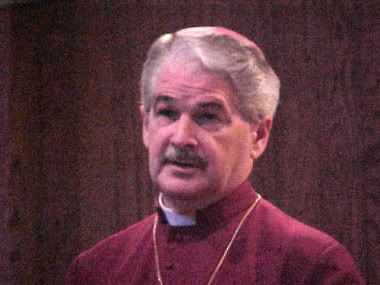
The Rt Rev'd Jack Leo Iker, III Bishop of Fort Worth.
A group of liberal opposition called the Council of Laity nominated Fr. John Payne of All Saints’ Church in Wichita Falls, Texas from the floor of the convention, held in October of 1992. Although originally a member of the ESA, Payne had grown to favor the ordination of women. The Rev’d Jack Iker won decisively on the sixth ballot, but the opposition party refused to join the customary unanimous resolution vote out of protest over his opposition to the ordination of women. (20)
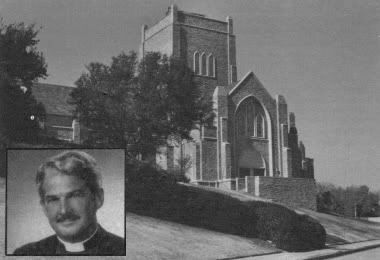
St Stephen's Presbyterian Church in Fort Worth, the site of the consecration.
The Council of Laity continued their protest by a campaign to thwart the process of consent from other diocesan standing committees and bishops. Within a short time of the election, a significant number of refusals came in from standing committees across the Episcopal Church. Bishop Pope called Iker at the time and advised him to not resign from his parish nor come to look for a house in Fort Worth just yet. A very slim margin of standing committee consents was finally obtained on 26 January 1993, after a push by Bishops Benitez, Bowman, and Kelshaw who insisted that the Church honor its commitments to tolerance on the women’s ordination issue. (21) Iker was finally consecrated as a bishop on 24 April 1993 at St. Stephen’s Presbyterian Church in Fort Worth amid picketers outside, and six formal protests inside. (22)
5. A Renewed Focus on Mission
Upon the retirement of Clarence Pope in 1995, Jack Leo Iker became the third Bishop of Fort Worth. Bishop Iker’s pontificate has been marked by growing unity and revitalization on the diocesan level. Since his election, Iker has explicitly attempted to build bridges with both those who supported and opposed him. “I recognize and respect your position and rightful place in the church,” he told convention delegates. “I make the commitment to love you and work with you wherever you happen to be on the theological spectrum. I simply ask you to do the same.” While he has remained active in the ESA (now Forward in Faith, North America), Iker has not taken on leadership of the organization as did Bishop Pope.
Bishop Iker has also been vocal about his commitment to stay in the Episcopal Church. One of his first actions was to designate St. Vincent’s Church in Bedford—a young, vibrant congregation—as the pro-Cathedral for the duration of his episcopate. Like Bishop Terwilliger, the late suffragan of Dallas, Iker has decided not to confront the Episcopal Church by threatening to leave, but by threatening to stay.
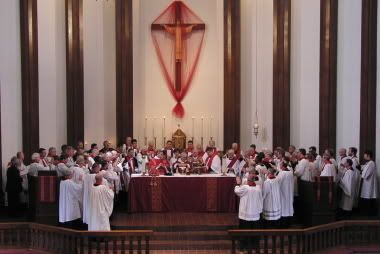
The Chrism Mass at St Vincent's Cathedral in Bedford, TX.
As coadjuctor, Bishop Iker presided over the last diocesan convention (October 1994) before Bishop Pope’s retirement. The executive director of the ESA, Fr. Samuel Edwards, proposed resolutions that would have repealed Article 1 of the diocesan constitution, and enabled parishes to secede with their property, and would have removed from parishes the option of sending money to the national church. “We need to begin disengaging from a morally corrupt national organizational structure,” said Fr. Edwards. Edwards argued that the action would not exactly be leaving the Episcopal Church, but only disengaging from it’s national control.
But Bishop Iker countered from the chair that passage of the resolution would in fact mean the diocese would be seceding from the Episcopal Church, and urged others to vote against the resolutions. Although national issues may be troubling, Iker noted, leaving is not the way to address the problem. The resolutions were rejected.
Similarly, when Bishop Pope announced his decision to leave the Episcopal Church, Bishop Iker quickly put out a pastoral letter in which he expressed sympathy with Pope’s concerns, but also stated: "It should be stressed that this is a personal decision of Bishop Pope’s and indicates no change of direction for the Diocese of Fort Worth. This is a time for us all to pull closer together as a diocese and to move forward with the work God has given us to do with gladness and singleness of heart. I still believe we have an important role to play within the Episcopal Church, and by God’s grace, I intend to lead us in this vocation with courage and enthusiasm."
Despite conflict with the national church, or perhaps because of it (with a growing sense of the irrelevance of national church policies), the Diocese of Fort Worth has steered away from separatist political considerations and focused more on renewal and mission at home. One of Bishop Iker’s stated goals for the diocese was a plan for emphasis upon evangelism and spiritual renewal.
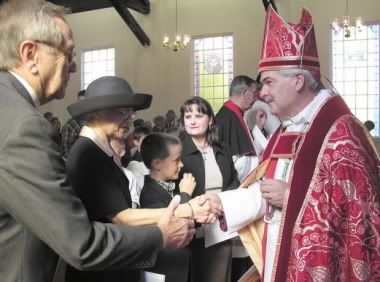
This led to his first Conference on Evangelism and Renewal, held at the downtown parish of St. Andrew’s in April of 1995. The conference was called a spiritual pep rally by the bishop. It also provided important workshops for clergy and lay leaders on learning to joyfully and effectively share the gospel within and beyond their congregations. “We must be anointed by God and empowered by the Spirit to go forth and share the good news with others,” said Iker. But, he added that we must also “first be convinced ourselves that it is good news, and that it is worth sharing.”
In a further attempt to build bridges and meet needs at home in the diocese, Bishop Iker developed “The Dallas Plan” together with Bishop James Stanton of Dallas. This informal pastoral arrangement was developed to meet the needs of potential female ordinands as well as congregations on both sides of the issue of women’s ordination. The agreement supplies workable provisions for both the ordination and priestly ministry of women. At present, no congregation has called a female assistant priest or rector, but several women have been ordained to the priesthood through the Dallas Plan.
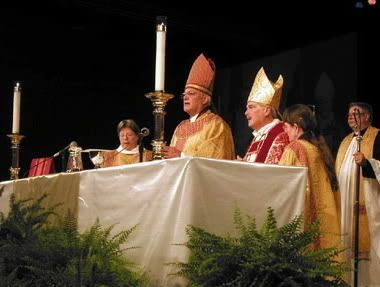
Bishop Iker at the Altar with Dallas Bishop James M. Stanton.
In spite of this agreement, the 1997 General Convention voted to amend the canons to make the ordination of women mandatory in all dioceses of the Episcopal Church. “The tragic thing,” noted Iker, “is that they are seeking to require something that the Scriptures do not require.” It was also the Anglican principle of not requiring things not found in holy Scripture which led to a diocesan constitutional amendment, qualifying the moral teaching authority of General Convention.
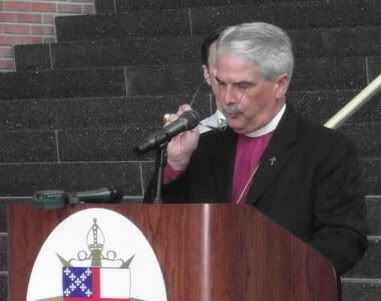
Because of the impending approval of same-sex blessings by the national church, the 1997 diocesan convention of Fort Worth changed the wording of the diocesan constitution to indicate that it recognizes the authority of the national Constitution and Canons and the General Convention, “provided that no action of General Convention which is contrary to Holy Scripture and the Apostolic Teaching of the Church shall be of any force or effect” in the Episcopal Diocese of Fort Worth.
Although the constitutional change does not weaken the tension with the national church, it does allow the diocese to remain in the Episcopal Church while in good conscience remaining loyal to Anglican tradition. The Bishop also cautioned against reading too much into the change. “I want to say again that I am not leading a secret movement out of the Episcopal Church,” Iker stated to the delegates. “I am working to carve out a place to stand. I will do whatever it takes to defend this diocese from revisionism, heresy, and factionalism.”
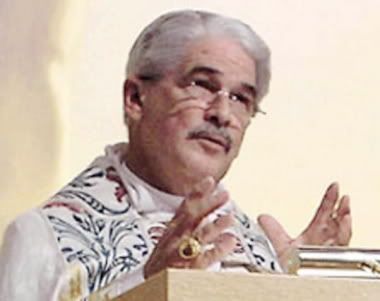
Indeed, Bishop Iker has called Fort Worth anew to its purpose since the beginning of the Church crossed into Texas—being a missionary Church. Following the bishop’s request in September 2001, the Executive Council adopted as the mission statement for Fort Worth: “To equip the Saints for the work of ministry” (Eph 4:12). At the 2001 Diocesan Convention, Iker noted: "The central theme that I have turned to year after year in these convention addresses has been the same for the past nine years—mission. I have called us to become a truly missionary diocese, focused upon evangelism, outreach, and church growth."
The future of the church in Fort Worth lies in carrying on its heritage—the apostolic work of ministry, rooted in the catholic faith.
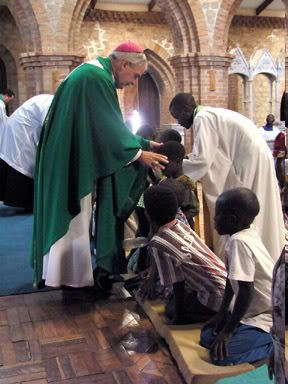
Bishop Iker on a mission trip in the companion Diocese of Northern Malawi.
Notes
1. Lawrence L. Brown, “Protestant Episcopal Church,” in the Online Texas Handbook.
2. Clause A. Beesley, The Episcopal Church in Northern Texas (Wichita Falls: privately printed, 1952), 13, 10.
3. Ibid., 20, 32.
4. C. Preston Wiles, The Episcopal Diocese of Dallas: A Centennial Narrative History (Dallas: privately printed, 1995), 9-25.
5. Ibid., 26.
6. Ibid., 46.
7. Quoted in The Living Church 185, no. 24 (12 December 1982): 7.
8. Ibid.
9. Ibid.
10. Reported in an article by Helen Parmley in the Dallas Morning News, cited in The Christian Challenge XXII, no. 5 (May 1983): 18.
11. Alexander C. Garrett, The Church: Its Mission and Principals of Growth (Hartford: Wiley, Waterman, & Eaton, 1876.), 25.
12. A. Donald Davies, “The Bishop’s Address to the First Annual Convention of the Episcopal Diocese of Forth Worth,” (sermon of the opening Eucharist of the Convention at Trinity Episcopal Church, Forth Worth, TX) 8 October 1983.
13. The Living Church 191, no. 25 (22 December 1985): 7.
14. A. Donald Davies, ed., The Episcopal Synod of America: Speeches, Sermons, Documents and Pictures from the Founding Meeting (Harrisburg, PA: Morehouse, 1990), 107-110.
15. David L. Holmes, A Brief History of the Episcopal Church (Harrisburg, PA: Trinity, 1993), 169-70; and Davies, ed., Ibid., 121-122.
16. The Living Church 209, no. 20 (13 November 1994): 6.
17. For a detailed narrative of the negotiations for union with Rome, see: William Oddie, The Roman Option: Crisis and the Realignment of English-speaking Christianity. New York: HarperCollins, 1997. Available used.
18. The Living Church 209, no. 20 (13 November 1994): 6.
19. The Living Church 211, no. 11 (10 September 1995): 19.
20. The Living Church 205, no. 17 (25 October 1992): 6.
21. The Christian Challenge XXXII, no. 2 (March 1993): 16-17.
22. The Living Church 206, no. 20 (16 May 1993): 6.
23. The Living Church 205, no. 17 (25 October 1992): 6.
24. The Living Church 209, no. 18 (30 October 1994): 6.
25. The Living Church 209, no. 20 (13 November 1994): 6.
26. The Living Church 210, no. 25 (18 June 1995): 6.
27. As Bishop Iker explained, “Any woman in this Diocese who wishes to enter into the ordination process for the priesthood must first secure the endorsement of her parish priest and then arrange for an interview of the two of them with me. I then recommend her to Bishop Stanton so that she may enter into the discernment process in Dallas. If any congregation here insists on going against my wishes and must have a woman priest at their church, I am willing to relinquish my episcopal oversight of that congregation to Bishop Stanton, so that he may license and institute a woman priest there. The congregation would remain fully a part of this Diocese; the woman priest would be fully a part of the Diocese of Dallas, while serving under this special pastoral provision. The desire to continue to live and work together, in spite of differences on this issue, means that this is a good and workable plan for this Diocese” (from the Forward in Mission, a publication of the Episcopal Diocese of Fort Worth, September 1997).
28. Jack L. Iker, “Conservatively Speaking.” Interview by Jim DeLa (Advent 2000). The Southern Cross, a publication of the Diocese of Southwest Florida; c.f., Article VI of the Articles of Religion, in The Book of Common Prayer, 868.
29. The Living Church 215, no. 23 (7 December 1997): 6.
30. Ibid., 8.
31. Jack L. Iker, “The Bishop’s Address to the Nineteenth Annual Convention of the Episcopal Diocese of Forth Worth,” (sermon of the opening Eucharist of the Convention at the Church of the Holy Apostles, Forth Worth, TX) 9 November 2001.


3 comments:
I feel we are very blessed to have Bishop Iker as our bishop. It's very disappointing to hear some of the names he is called. I wonder if they would still call him names if they got to know him. He's a kindhearted soul.
Wow, this is very interesting and informative. Thanks!
Andyhttp
Bishop Iker released the following statement on 6 August 2007:
"BISHOP CLARENCE POPE telephoned me this morning to let me know that Martha and he have returned to membership in the Roman Catholic Church, in full communion with the See of Peter. We certainly wish them well and want to uphold them with our love and prayers at this important time in their pilgrimage. They both gave ten years of faithful service and witness here in the Diocese of Fort Worth, and we give thanks to God for their continuing friendship and ministry. Bishop Pope wanted to assure me that he remains very attached to us and that his affection for the people of this diocese remains unchanged. Do join me in thanking God for both of these faithful Christians and praying His continued blessing upon them in the years ahead."
Something tells me that KJS, unlike Bishop Browning, will not be on the phone trying to talk Clarence Pope back into the fold.
Post a Comment